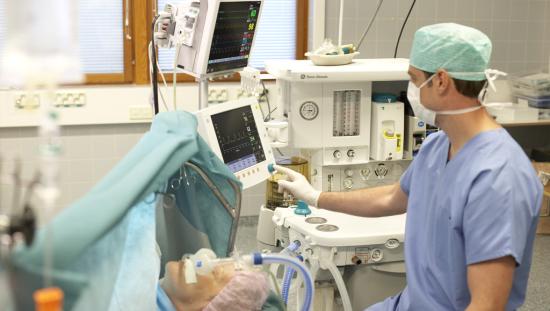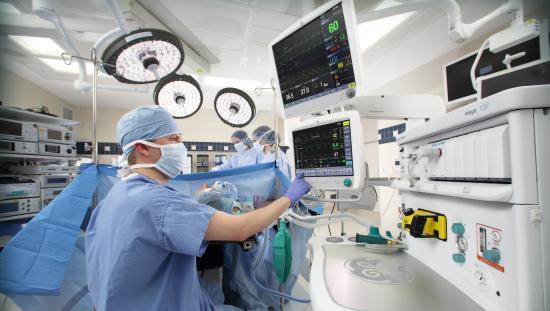
Alveolar recruitment maneuvers (ARMs) are used to reopen collapsed alveoli in ventilated patients during general anesthesia. They are also used to improve lung mechanics and help maintain overall lung function with the goal of reducing postoperative pulmonary complications (PPC’s)1 .
While evidence continues to show the benefits of using ARMs, there are no formal guidelines as to when or how frequently ARMs should be used. There is also an overarching hesitation for many clinicians to implement ARMs into standard practice.
Today’s article discusses factors to consider when deciding whether to use ARMs as well as some of the benefits associated with ARMs based on clinical research.
Are Alveolar Recruitment Maneuvers (ARMs) Safe?
Confusion around utility and safety are two main reasons clinicians avoid or fail to use recruitment maneuvers.
Intubation and mechanical ventilation are associated with an increased risk of atelectasis and potential alveolar collapse2. This general knowledge has contributed to clinicians taking caution when it comes to using additional ventilator support, such as recruitment maneuvers, to support patients and reduce lung injury.
Many studies have looked at the risks associated with ARMs and have demonstrated their safety and efficacy. A meta-analysis reviewed 439 studies around the impact of recruitment maneuvers on patient mortality and noted that ARMs had many benefits related to lung protective ventilation. Benefits of using ARMs include:2
- Improved intraoperative oxygenation
- Reduced need for high oxygen concentrations
- Corrected intraoperative hypoxemia
- Reduced postoperative pulmonary complications (PPCs)
The meta-analysis also noted when ARMs are not indicated.2 Recruitment maneuvers are contraindicated in patients with severe hypotension, patients with head trauma or transcranial hypertension, or patients undergoing open eye surgery. Pulmonary related contraindications included patients with an undrained pneumothorax and, patients with bronchospasm, pulmonary emphysema, or lung bullae.2
Some researchers feel there isn’t sufficient evidence to advise using ARMs every time after induction.1 However, in this review specifically, the benefits outweighed the consequences, leading some researchers to always use recruitment maneuvers (followed by PEEP) immediately after anesthesia induction, unless it is contraindicated.2
ARMs Increase Oxygenation
When patients are suffering an acute lung injury, recruitment maneuvers may be used to improve oxygenation3. Due to the benefits of recruitment maneuvers during acute injuries, researchers explored the benefit of using recruitment maneuvers as a prophylactic measure.
Researchers looked at the benefits of using recruitment maneuvers immediately after intubation in hypoxic patients who required intubation while in the intensive care unit. Patients who received recruitment maneuvers had significantly higher oxygen levels compared to the control group.3
Even 30 minutes after intubation, those who received recruitment maneuvers still had significantly higher oxygen levels.3The study also found that recruitment maneuvers immediately after intubation did not contribute to an increase in adverse effects, highlighting the safety of using recruitment maneuvers to support lung protective ventilation.3
Improved Pulmonary Compliance and PPC Reduction
Pulmonary compliance can decrease during mechanical ventilation due to the inability of the patient to periodically sigh. Monitoring pulmonary compliance and finding ways to increase or maintain it can help ensure adequate alveolar expansion and oxygenation4.
When ARMs are used during ventilation, one study showed that patients have improved respiratory resistance under general anesthesia as well as increased lung compliance5. A second study supporting this conclusion showed that pulmonary compliance increased in patients who received ARMs when compared to control groups with an increase in PaO2/FiO2 as well.4
PPCs are possible when using mechanical ventilation due to the risk of pulmonary stress and lung injury. Reducing the risk of PPCs can have a profound impact on 30-day patient mortality rates considering that one in every five patients can experience PPCs.1
An expert review of the research provided a ‘strong’ recommendation supporting the use of ARMs to help reverse alveolar collapse when used with PEEP.1 ARMs support lung protective ventilation and may help reduce the risk of PPCs by improving areas of alveolar closure, which subsequently decreases mechanical stressors known to cause lung injury6.
Secondary Benefits of ARMs
Clinicians know what happens in the OR doesn’t stay in the OR. The effects of anesthesia and ventilation can have consequences on patients once they leave the operating room.
Although studies have found mixed results, postoperative PaO2 and SpO2 was shown to be either improved or remained stable in patients who received ARMs intraoperatively.4
Another study looked for any difference in patient status in three different groups: one receiving PEEP only, one receiving a single ARM, and one group receiving PEEP directly after ARMs. Those who had ARMs followed by PEEP not only had increased lung compliance and intraoperative PaO2, but they also had reduced hospital stays.4
ARMs Should Be Used With Other Lung Protective Interventions
Although ARMS can play an important role when it comes to lung protective ventilation, this practice cannot be done alone. While ARMs can help reopen collapsed alveoli, the risk for subsequent collapse immediately post-ARM is high.1
Using lower FiO2 and individualized PEEP in conjunction with ARMs has proven to be most effective in the surgical setting since using ARMs alone has not shown to have significant benefit.1
Summary
- Recruitment maneuvers carry many benefits when it comes to lung protective ventilation
- The decision to use ARMs still depends on patient assessment as well as clinician preference
- Increased oxygenation and lung compliance as well as reducing the risk of PPCs are all proven benefits of ARMs
- Improved patient outcomes may occur when ARMs are used in conjunction with individualized PEEP and lower FiO2 rather than ARMs alone
References
[1] Young, C et al. (2019). Lung-protective ventilation for the surgical patient: international expert panel-based consensus recommendations. British Journal of Anesesthesia. 126(6). 898-913.
[2] García-Fernández, J, Romero, A, BlancoA,Gonzalez, P, Abad-Gurumeta, A, Bergese,SD. (2018). Maniobras de reclu-tamiento en anestesia: ¿qué más excusas para no usarlas? Rev Esp Anestesiol Reanim. 1-10.
[3] Constantin, JM et al. (2010). A recruitment maneuver increases oxygenation after intubation of hypoxemic intensive care unit patients: a randomized controlled study. Critical Care. 14(R76). 1-11.
[4] Hartland, B, Newell, T, & Damico, N. (2015). Alveolar recruitment maneuvers under general anesthesia: a systematic review of the literature. Respiratory Care. 60(4). 609-620.
[5] Nakahari, J, Nakano, S, & Minami, T. (2020). Evaluation of alveolar recruitment maneuver on respiratory resistance during general anesthesia: a prospective observational study. BMC Anesthesiology. 20(264). 1-7
[6] Tusman, G, Bohm, S, & Suarez-Sipmann, F. (2014). Alveolar recruitment maneuvers for one-lung ventilation during thoracic anesthesia. Curr Anesthesiol Rep. 4. 160169.
© GE, 2021 – All rights reserved.
GE and the GE Monogram are trademarks of GE. Reproduction in any form is forbidden without prior written permission from GE. Nothing in this material should be used to diagnose or treat any disease or condition. Readers must consult a healthcare professional.
JB18631XX













